Two minutes and 46 seconds. The time has passed since the pilot of the port of Baltimore He called the port authorities informing them that the container ship Dali had lost power until the two checkpoints guarding the two entrances to the Francis Scott Key Bridge closed it to road traffic. It was an incredibly fast action in which the pilot’s reflexes probably saved many lives, since he used his mobile phone since everyone the ship’s electrical installation had stopped working and that means that the radios were not operational either.
The speed of the pilot, whose name has not been disclosed, prevented a greater tragedy. The two dead and four missing – who are also presumed deceased – could have been many more if the bridge had remained open to traffic. Had the accident occurred during the day, the fatalities would have been in the hundreds or thousands.
The speed in the response to the incident will not now avoid a long and cumbersome process for the Dali sail again, the bridge is built again and the insurers take care of the expenses. Only removing the bridge will require seven giant floating cranes, 10 tugboats, nine barges, eight ships, and five coast guard vessels. The legal issue will be even more complex, which will surely last for years, since US legislation limits its payments in these incidents and, in any case, a responsible person or entity must first be identified.
At a structural level, the accident has shown that the United States is the leading world power but has infrastructures of developing countries. Although he puente Francis Scott Key had turned 37 precisely three days before the Dali would tear it down, it lacked what experts consider basic protective measures in a construction that crosses an area of enormous maritime traffic. This lack of preparation is normal on many bridges in the United States, and is a reflection of the appalling state of public works in that country.
In 2021, the United States spent 0.5% of its GDP on infrastructure. That means 89% less than China, or between half and a third than other countries with a similar level of development, such as Germany, France, the United Kingdom and South Korea. Investing more in that chapter was one of the priorities of Obama but his plans never went beyond being a set of good words. Donald Trump did the same, but the most he achieved was to create a series of conferences in the city of Washington titled Infrastructure Week that ended up becoming a source of jokes. Just Joe Biden It has achieved three historic packages for that chapter, but its effects will take decades to be noticed. This is how, for example, the Key Bridge – one of Washington’s landmark bridges over the Potomac River – was closed to traffic in 2016 because it was not safe for road traffic.
Infrastructures are also politicized. With Republicans opposing them because they consider them “wasteful,” especially when they promote public transportation, which for some members of that party is a “collectivist” and “socialist” practice. So, when Chris Christie achieved the position of governor of New Jersey. He canceled the construction of a bridge to link the state with the neighboring island of Manhattan, in New York, which has the same number of bridges and tunnels connecting it with the outside of the world for 53 years.
And, apart from the reconstruction of the bridge, another element has come into action: conspiracy theories. A video in which it is stated that the Dali -named in homage to Salvador Dal– changes course before colliding with the bridge, for example, has gone viral on X (the old Twitter), always repeating exactly the same phrase. The video, paradoxically, was created by the Indian military analyst Abhijit Iyer-Mitra and later taken up by accounts from that country and from around the world.
Iyer-Mitra backtracked on his statement within two hours of posting his first Tweet. But it was too late. To the conspiranoids were added bots. According to him software fight against disinformation online Cyabra, cited by US military analyst Ryan McBeth20% of the reproductions of that theory came from accounts that used Artificial intelligence (IA).
Others have been less subtle. This is the case of messages on social networks that blame the accident… on the racial minorities. They do not say it with those words, but rather they attribute the catastrophe to the DEI, which is the acronym in English for Diversity, Equity and Inclusion, the new acronym used by American companies and Administrations to admit racial minorities into them.
This has even been expressed by a member of Congress from the state of Utah, Phil Lyman who has cleverly targeted the only black woman on the Port of Baltimore board of directors for her criticism, Karentha Barber.
As Lyman finds out that the Dali took its name from a Spanish painter – a country that many Americans place somewhere between Mexico and Argentina – and its owner is from Singapore – that is, most likely Chinese and, if not, Indian -, it will not have the slightest There is no doubt that the cause of the catastrophe was not an electrical failure, but rather a racial one.
